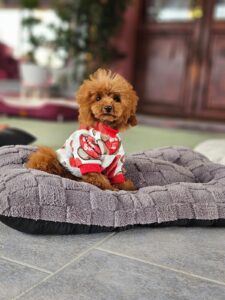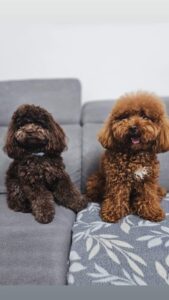Questions About Poodles
The Most Frequently Asked Questions About Poodles
At the Mater Dei Regina Pacis Kennel, we breed with passion, professionalism, and profound respect for the well-being of our puppies. Each Poodle born at our kennel is the result of careful genetic selection, a balanced growth path, and a loving education, ensuring they become faithful, happy, and healthy companions.
Every day, we receive numerous questions from those looking to welcome a Poodle puppy into their family. We know how important it is to have clear, reliable information to make an informed and responsible choice. For this reason, we’ve collected some of the most frequently asked questions, striving to offer comprehensive and helpful answers for those seeking a special life companion.
In this section, you’ll find information on essential aspects, such as:
- The size, build, and characteristics of the Toy Poodle and the Undersized Poodle.
- The best tips for properly raising and socializing your Poodle.
- What it means to us to breed with care, dedication, and professionalism, ensuring high standards and respect for the breed.
Our goal is not only to breed Poodles with high pedigrees, but above all to place each puppy in the right home, where they can be loved and cared for in the best possible way. Love for these little creatures is at the heart of our work, and we’re happy to share our experience with anyone who wishes to welcome a Poodle into their home.
If you don’t find the answer you’re looking for, don’t hesitate to contact us: we’ll be happy to guide you on this wonderful journey.

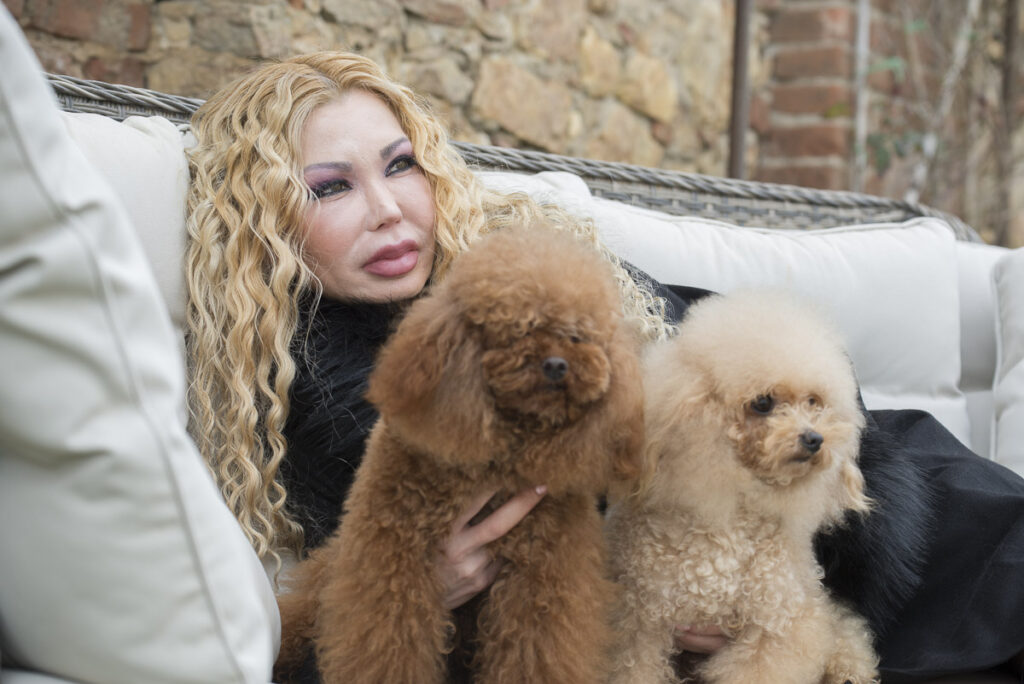
on poodle size
The poodle is the only breed, like the dachshund, that recognizes four different sizes: giant (large), medium, miniature, and toy. These are the recognized sizes, in addition to the names used to describe all the sizes that do not fall within the ENCI standard, such as undersized, mini-toy, teacup, and pocket poodles. We’ll try to provide some answers to your most common questions.
I was told that mini-toy poodles can't have a pedigree, is that true?
This information is incorrect. According to the ENCI standard, a pedigree is a document certifying a dog's ancestry.
An undersized poodle will have its own pedigree if it is born to a litter of parents with a valid pedigree who have obtained size confirmation, or to foreign breeders.
To be eligible for breeding in the poodle breed, after turning one year old, the dog must be measured in an ENCI-recognized event by an expert judge who will then measure the dog (size confirmation). If the poodle measures less than 23 cm, according to the ENCI standard, it cannot become a breeder, but this does not mean the dog does not have a valid pedigree, as the pedigree is inherited from the parents.
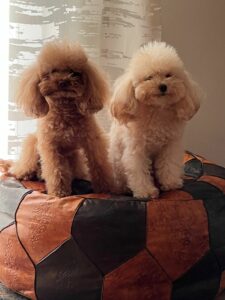
How can be defined the standard of beauty of a poodle?
According to the official breed standard, the beauty of a Poodle is defined by a combination of morphological characteristics, harmonious proportions, and an elegant posture. These elements are essential for evaluating a specimen's aesthetic quality, especially in dog shows. It's clear that this is too complex a topic to address briefly.
At the Mater Dei Regina Pacis kennel, we conduct a rigorous selection process that ensures, first and foremost, compliance with the breed standard, excluding from breeding specimens that may be carriers of diseases or exhibiting defects. For example, in the show arena and for admission to breeding, the ENCI requires dogs to have the correct number of incisors (6+6, i.e., six on the upper jaw and six on the lower jaw), a proper bite, and, for males, both testicles fully descended. Some distinguishing characteristics are the following.

Aspetto generale
Il Barbone è un cane di struttura armoniosa, con un aspetto che esprime eleganza e fierezza. La sua costruzione è equilibrata, con un corpo proporzionato e muscoloso. Il portamento è nobile, con una testa ben portata e un'andatura leggera e saltellante.
Mantello
Il mantello del Barbone è una delle sue caratteristiche distintive. Il pelo non presenta sottopelo e non subisce la muta, rendendolo ipoallergenico e adatto anche a persone sensibili. Presso il nostro allevamento siamo specializzati nella selezione del colore fulvo.
Proporzioni e struttura
Le proporzioni del corpo sono fondamentali: la lunghezza del corpo deve essere leggermente superiore all'altezza al garrese. La testa è ben proporzionata, con un cranio leggermente convesso e un muso rettilineo. Gli occhi sono a mandorla, di colore nero o marrone scuro, e le orecchie sono lunghe, pendenti e aderenti alle guance. La coda è attaccata alta e portata obliquamente. Il colore del tartufo è scuro.
What is it a teacup poodle?
The Teacup Poodle is a popular name for a small, undersized poodle, measuring between 18 and 20 cm in height. These dogs have distinct personality and physical characteristics. Highly sensitive and affectionate, delicate and slender, they require owners who are equally sensitive and needy, intuitive, and willing to provide the care and attention required of a dog of this breed. Despite their small size, they are dogs in their own right; they should not be humanized or treated as objects of desire. All dogs deserve treatment that respects their nature and unique characteristics. It's best to choose a different size!
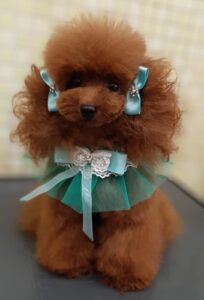
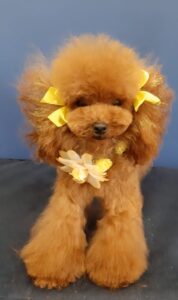
Poodle education and training
A well-trained dog is always a dog we can enjoy more in any situation, being able to take him with us everywhere. Given the great intelligence of this breed, good habits and dog-handling skills will help us make our relationship with our poodle friend, a great life companion, special.
How often should a poodle be bathed?
We recommend bathing your poodle at home or at a grooming salon once every one to two weeks, and finding a groomer who can take care of the haircut once a month. It's clear that daily brushing and weekly bathing will help your poodle maintain a shiny, tangle-free coat.
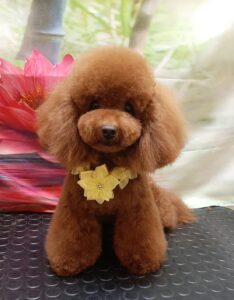
on poodle breeding
Evaluating the quality and professionalism of a breeder from which you choose your puppy is very important. Below are some frequently asked questions regarding the topic of choosing a poodle puppy.
Why doesn't a breeder answer the question about the price of the puppy?
Asking the price of a puppy right away can be a sign of a poor understanding of the commitment and responsibility involved in adopting a dog. A reputable breeder focuses on:
- The puppy's health and well-being.
- The dog's physical and personality traits to ensure a good fit for the adoptive family.
- Genetic selection to ensure fewer health problems and a better quality of life.
- Comparing the price of a puppy to a simple business transaction devalues the work of selection and care undertaken by the breeder.
For these main reasons, many breeders avoid responding to requests based solely on price, preferring to delve deeper into the buyer's motivation and ability to care for the dog.
How much does a puppy cost?
The price of a puppy doesn't depend solely on its size or breed; it's determined by several factors, including selection, bloodline quality, and the puppy's preparation for life. The value of a puppy can't be reduced to a simple figure, as it involves a long process of breeding, care, and selection to ensure health, well-being, and high breed standards.
Today, the market is full of "puppies everywhere," but that doesn't mean they all have the same level of quality and care. Are we often asked how much does a toy poodle cost? It's not just the size that determines the price. What determines the price is the selection process for a breed and the puppy's preparation for life. These are complex topics because there's little information, and what is available isn't of the highest quality. Nowadays, there are "puppies everywhere," so if someone asks me how much a puppy costs, I give a vague answer.
If you'd like to know the cost of our puppies and understand the work that goes into it, we invite you to visit us at the kennel or contact us by phone for more information.

